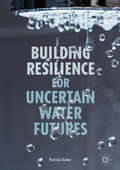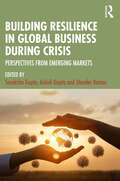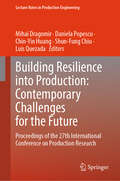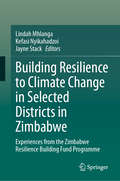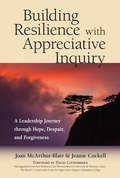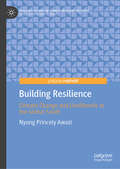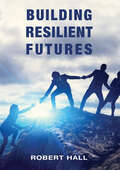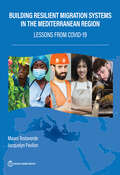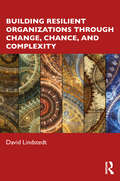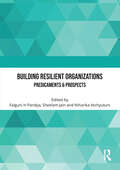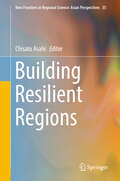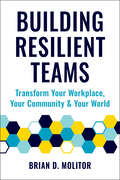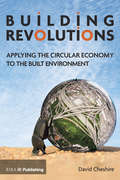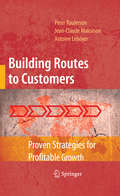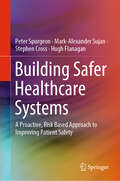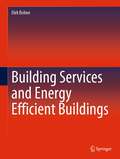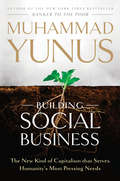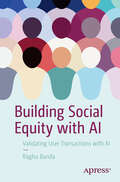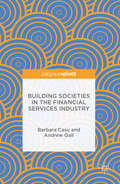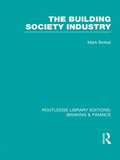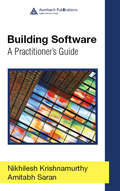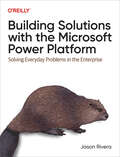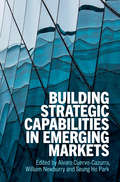- Table View
- List View
Building Resilience for Uncertain Water Futures
by Patricia GoberThis book describes the existential threats facing the global water systems from population growth and economic development, unsustainable use, environmental change, and weak and fragmented governance. It argues that ‘business-as-usual’ water science and management cannot solve global water problems because today’s water systems are increasingly complex and face uncertain future conditions. Instead, a more holistic, strategic, agile and publically engaged process of water decision making is needed.Building Resilience for Uncertain Water Futures emphasises the importance of adaptation through a series of case studies of cities, regions, and communities that have experimented with anticipatory policy-making, scenario development, and public engagement. By shifting perspective from an emphasis on management to one of adaptation, the book emphasizes the capacity to manage uncertainties, the need for cross-sector coordination, and mechanisms for engaging stakeholder with differing goals and conflict resolution. This book will be a useful resource for students and academics seeking a better understanding of sustainable water use, water policy and water resources management.
Building Resilience in Global Business During Crisis: Perspectives from Emerging Markets
by Ashish Gupta Suraksha Gupta Jitender KumarA series of calamities has, in recent years, had an impact on business performance. This book explores strategies and business responses in times of crisis.The COVID-19 pandemic and the hyper competitive market environment have compelled organizations and industries to redraw the limits of their operational and strategic activities. Organizations in emerging markets are facing a great challenge in keeping their businesses afloat in these difficult times. This book offers an insight into how businesses and markets have been affected globally. Focusing especially on emerging countries and markets, it presents an assessment of how they can adapt their strategies to respond to the current trends and crises. Examining effective management techniques and practices, consumer behavior, supply chain and human resources management from an interdisciplinary perspective, the book draws links between businesses, consumers and academic theories on business management, marketing and consumer studies.This book will be an indispensable resource for managers in different sectors. It will also be of interest to researchers and students of business studies, management studies, marketing, strategic management, global business outsourcing, global business environment, besides being of use to government agencies, practicing managers and research agencies.
Building Resilience into Production: Proceedings of the 27th International Conference on Production Research (Lecture Notes in Production Engineering)
by Chin-Yin Huang Daniela Popescu Luis Quezada Mihai Dragomir Shun-Fung ChiuThis book contains the proceedings of the 27th International Conference on Production Research (ICPR). ICPR is a biennial conference that has been hosted for more than a half century. It is regarded worldwide as one of the leading conferences on production research, industrial engineering, and related subjects. This year&’s conference has a special focus on advances in production resilience through digital technologies, sustainability and the management of disruptive events. This book is of interest to researchers, students, and professionals in industry.
Building Resilience to Climate Change in Selected Districts in Zimbabwe: Experiences from the Zimbabwe Resilience Building Fund Programme
by Lindah Mhlanga Kefasi Nyikahadzoi Jayne StackThe book is based on Zimbabwe Resilience Building Fund data from the Outcome Monitoring Surveys 1,2,3 (OMS123) which comprised of three rounds of panel data set with the same households being interviewed three consecutive times in 18 districts. The OMS1, OMS2 and OMS3 were undertaken in 2019, 2020 and 2021, respectively. The findings in this book demonstrate and provide a better understanding of what works and what does not work to strengthen communities’ resilience in Zimbabwe. The information contributed in each chapter will be useful to inform adaptive programming and design of future resilience interventions and policy, with a focus on Climate Resilient Development (CRD). The chapters also address the challenge of formulating concrete policy in an environment with severe data constraints.
Building Resilience with Appreciative Inquiry: A Leadership Journey through Hope, Despair, and Forgiveness
by Jeanie Cockell Joan McArthur-BlairJourney through hope, despair, and forgivenessLeaders cannot predict the complex challenges they are called on to face. Veteran consultants Joan McArthur-Blair and Jeanie Cockell show that Appreciative Inquiry (AI) is an invaluable tool to build resilience.AI is a widely used change approach that emphasizes identifying what's working well in a system. Leaders can use AI to increase their ability to weather the storms they'll inevitably encounter and be resilient. A profound guide, this book features personal accounts from leaders across a variety of settings describing how they've practiced appreciative resilience in the ongoing cycle of hope, despair, and forgiveness.
Building Resilience: Climate Change and Livelihoods in the Global South (Palgrave Studies in Climate Resilient Societies)
by Nyong Princely AwaziThis book explores the intersection of climate resilience, livelihoods, and sustainability in various sectors – from forestry to fisheries and agriculture – within the global South. The author provides a comprehensive examination of how climate change impacts these communities, the adaptive strategies they employ, and the policy frameworks necessary for promoting resilience. Through a multidisciplinary approach that integrates ecological, economic, and social dimensions, this book is an essential resource for policymakers, researchers, and practitioners in fields relating to fishery, forestry and agriculture in the global South.
Building Resilient Futures
by Robert HallWhether a community struggling to keep its members buoyant, a business trying to stay solvent, or a nation fighting to protect its citizens, adversity and crisis impact us all. The resilient are able to pick themselves up, dust themselves off, and not only bounce back but also bounce forward. This book looks at what resilience means at times of crises as well as the in-between periods. It examines the various types of resilience, such as emotional, organisational and societal, and offers valuable insights on how to manage the consequences of upheaval and trauma. The author brings together contributors to deliver a real mix of theory, case-study evidence and anecdote in a way that is both approachable and thought provoking. It is a timely and necessary addition to a crucial topic. Very simply, professionals, practitioners, students, government ministers, and business leaders should read this now. It might be a safer, better world if people read the book and acted on it.
Building Resilient Migration Systems in the Mediterranean Region: Lessons from COVID-19
by Mauro Testaverde Jacquelyn PavilonFor thousands of years, migration has been a source of social and economic well-being for people living on different shores of the Mediterranean Sea. Whether through higher earnings for migrants, access to labor for receiving countries, or remittances for sending communities, migration has been an important driver of development in the Mediterranean region. The COVID-19 (coronavirus) pandemic has severely disrupted this complex web of movements, raising questions about whether migration will continue to be an important driver of the region’s well-being. As time passed, it became clear that the drivers of migration are so strong that mobility restrictions can only reduce movements, not halt them entirely. Building Resilient Migration Systems in the Mediterranean Region: Lessons from COVID-19 presents evidence on the implications of the COVID-19 pandemic on mobility in the region to inform policy responses that can help countries restart migration safely and better respond to future shocks. While some of the challenges that emerged during the pandemic are specific to public health crises, others are common to different types of shocks, including those related to economic, conflict, or climate-related factors. To inform this reform process, this book suggests a set of actions that can help Mediterranean countries to maximize the benefits of migration for all people living in the region, while at the same time ensuring the sustainability of migration flows. As a whole, these proposed policy actions point to a vision of migration resilience that, even during crises, can address key labor shortages, keep both migrant and native populations safer, sustain household incomes, and ameliorate blows to economic growth. The COVID-19 pandemic has created momentum for policy reforms. Whether this crisis can illuminate the way toward better adapting migration systems to future crises will depend on learning its lessons.
Building Resilient Organizations through Change, Chance, and Complexity
by David LindstedtA must-read in the wake of COVID-19, this book unpacks the nature of resilient organizations and how they prepare for unpredictable, complex, and profound change. Organizations that do not adapt and evolve die. To date, however, it has not been at all clear how to build a resilient organization. That puts us all in the unenviable position of trying to ready our organizations for an increasingly uncertain future without the proper guidance to do it. This book introduces 14 elements of resilience that consistently emerge in organizations that have thrived amid adversity and volatility. Resilience is not about determination, grit, cybersecurity, or teams of resilient individuals; resilience, it turns out, is often confused with robustness. Readers will discover how resilient organizations build and employ a distinctive combination of crews, capital, culture, and leadership—and, crucially—how to adapt these combinations for their own organization. Senior business leaders, consultants, entrepreneurs, students, and professionals will appreciate this book’s practical, approachable, and engaging guidance, including insights by leaders from Health Care for the Homeless, The Ohio State University, NBCUniversal, retail stores, and more.
Building Resilient Organizations: Proceedings of the 4th International Conference on “Impact of Current Events on the Future of Business” (4th ICEFB, 2022), Hyderabad, Telangana, India on 7-9 April, 2022
by Falguni H Pandya Sheelam Jain Niharika AtchyutuniThis book is aimed at contemplating and reflecting on future course of action for businesses in order to become more resilient. It discusses various predicaments and prospects around building enduring organizations. By demonstrating how to build strong and resilient systems that can survive catastrophes witnessed in the past few years, it offers practical solutions by discussing the current researches, the-oretical insights, experiences and lessons which can inspire and empower business leaders, academics, students, policy makers and other stakeholders in economics.
Building Resilient Regions (New Frontiers in Regional Science: Asian Perspectives #35)
by Chisato AsahiThis book focuses on building regional resilience by comprehensively improving regional assets. Regional vulnerability depends on the availability of regional assets for the population, as well as the population’s ability to access those assets. Such assets include the environment, population size, community, and human capital, as well as traditional physical infrastructure. Identifying and improving these regional assets, which provide resource flows to help cope with regional disruptions—natural disasters, economic crises, or demographic changes— serves to mitigate vulnerability and build resiliency. The book pursues an interdisciplinary approach to investigating regional resilience, bringing together welfare and environmental economics, public administration, risk and disaster management, policy studies, development studies, and landscape architecture. Up-to-date case studies are provided, including recovery from the Great East Japan Earthquake in Japan, regional development for depopulation areas, and urban policy for smart cities. These studies reflect and share the latest findings on key issues, policymaking and implementation processes, and implications for evaluation methodologies—all of which are indispensable to the building of resilient regions. This book is highly recommended for researchers and practitioners seeking a fresh, interdisciplinary approach to regional and urban development. It provides a valuable reference guide to building resiliency and mitigating vulnerability, both of which are imperative to achieving sustainable regions.
Building Resilient Teams: How to Transform Your Workplace, Your Community and Your World
by Brian MolitorAn essential how-to guide to building more efficient and successful organizations at work, in our communities, and in the world as we discover how our humanity transcends all.In an age of self-care and mindfulness, Building Resilient Teams translates those concepts and turns it into the group. All of us are parts of communities, neighborhoods, and other organized systems. These organizations and teams can be further characterized as places where we work, play or worship. The impact of a negative or under productive workplace on individual lives is huge. The good news is that organizations, much like people, can learn, grow and transform once there is a clear path ahead with logical mile markers along the way. Building Resilient Teams provides step-by-step instructions on how to take any organization from where it is now to a level of higher success.
Building Respected Companies
by Jordi CanalsThe current financial crisis has deep macroeconomic roots, but the dominant view of the firm has made the crisis deeper and more devastating. Over the past few decades, maximizing shareholder value has become the main objective of the firm. Chief executives have been keen on this objective because their economic incentives have been clearly associated with stock market performance. Unfortunately, this has driven many CEOs to make terrible decisions based on short-termism and greed. In this way, the firm has become the object of anger, criticism and cynicism. In Building Respected Companies, Jordi Canals argues that we must address this problem by developing companies that serve society, not just their shareholders. This requires a new perspective of what a firm is, what the purpose of the firm in society should be and what the role of the board of directors and senior executives should be.
Building Revolutions: Applying the Circular Economy to the Built Environment
by David CheshireThe construction industry operates within a linear economy of make, use, dispose. Buildings are stripped out and torn down with astonishing regularity while new buildings are constructed from hard-won virgin materials. But raw materials are becoming scarce, and the demands for them are exploiting fragile ecosystems, even as the global demand for resources continues to rise. Policy makers and organisations are beginning to look for a more regenerative, circular economy model. The construction industry demands over half the world’s extracted materials and generates around a third of the total waste generated in the EU, making it a prime candidate for applying the circular economy. Yet there has been little focus on how construction industry professionals and their clients can contribute towards the movement. Drawing on illustrative methods and examples, Building Revolutions explains how the principles of a circular economy can be applied to the built environment where resources are kept in use and their value retained.
Building Routes to Customers: Proven Strategies for Profitable Growth
by Jean-Claude Malraison Antoine Leboyer Peter RaulersonBuilding Routes to Customers explains the powerful "Routes-to-Market" approach for driving profitable growth. World-class organizations including IBM, Microsoft, HP, Cisco, Hitachi, Adobe and Plantronics, and hundreds of smaller companies, have adopted RTM to develop and execute highly successful go-to-market strategies and tactics. With a step-by-step approach and dozens of examples, the authors show how you can use RTM to: (1) Determine the optimal level of spending for each function in marketing, sales and customer service, for each market segment, product and service. (2) Optimize your marketing mix and sales and distribution channels to maximize revenue and profitability throughout the product life cycle. (3) Get everyone in product management, marketing, sales, customer service, and your distribution partners aligned and working together to maximize results. (4) Get the right products and services to the right customers at the right time. (5) Retain existing customers and create profitable new ones.
Building Safer Healthcare Systems: A Proactive, Risk Based Approach to Improving Patient Safety
by Peter Spurgeon Mark-Alexander Sujan Stephen Cross Hugh FlanaganThis book offers a new, practical approach to healthcare reform. Departing from the priorities applied in traditional approaches, it instead assesses – both theoretically and practically – the successful lessons learned in other safety-critical industries, and applies them to healthcare settings. The authors focus on the importance of human factors and performance measures to establish proactive, systematic methods for healthcare system design. This approach helps to identify potential hazards before accidents occur, enhancing patient safety. In addition, the book details the new approach on the basis of real-world applications in the NHS and insights from NHS staff. Case studies and results are presented, demonstrating the significant improvements that can be achieved in risk reduction and safety culture. Lastly, the book outlines what steps healthcare organisations need to take in order to successfully adopt this new approach. The approach and experiential learning is brought together through the development of a new holistic patient safety education syllabus.
Building Services and Energy Efficient Buildings
by Dirk BohneAuf dem neuesten “Stand der Technik” präsentiert sich das Buch noch übersichtlicher mit einer neu gegliederten, äußerst benutzerfreundlichen Darbietung des Stoffes. Das Fachwissen wurde dabei konzentriert und komprimiert auf die für Architekten und Bauingenieure relevanten Sachverhalte und Zusammenhänge. Komplett neu gestaltet wurde der umfangreiche Abbildungsteil mit hochwertigen Zeichnungen zur bildhaften Kommentierung des Textes. Um im Technischen Ausbau mit der technologischen Entwicklung, den steigenden Komfortansprüchen und den Erfordernissen eines wirtschaftlichen und umweltfreundlichen Umgangs mit der Energie Schritt zu halten, ist der “Wellpott/ Bohne” weiterhin ein unverzichtbares Grundlagenbuch.
Building Smart Neighborhoods at Bouygues
by Amy C. Edmondson Bertrand Moingeon Jean-Francois Harvey Guo BaiCan a consortium of 16 organizations, including multinational corporations, local government agencies, and startups, turn a run-down Paris suburb into a "smart" (ecologically viable, high-tech, livable) neighborhood? This case explores how Bouygues Immobilier led such a project involving Alstom, Bouygues Energies & Services, Bouygues Telecom, EDF (Electricity of France), ERDF (Electricity Distribution Grid of France), Microsoft, Schneider Electric, Steria, and Total in Issy-les-Moulineaux (France). The enormous scope and diversity of the project is presented as well as the teaming strategies and governance model that facilitated its success. IssyGrid earned the "Golden Issy" and "Grand Paris," among other awards, for its innovation and performance.
Building Social Business: The New Kind of Capitalism That Serves Humanity's Most Pressing Needs
by Muhammad YunusNobel Prize winner and bestselling author of Banker to the Poor,shows how entrepreneurial spirit and business smarts can be harnessed to create sustainable businesses that can solve the world's biggest problems--a reminder that capitalism can take kindlier forms&” (Spectator) Social business is a visionary new model for capitalism developed by Muhammad Yunus, the practical genius who pioneered microcredit and won the Nobel Peace Prize for his efforts to combat global poverty. Now social business, which harnesses the energy of capitalism to fulfill human needs rather than reward shareholders, is being adopted by leading corporations as well as entrepreneurs and social activists across Asia, South America, Europe, and the United States. Through examples of corporations such as BASF, Adidas, Danone, Uniqlo, and others, Building Social Business shows how an inspiring theory has become a world-altering practice, and offers practical guidance for those who want to create social businesses of their own.
Building Social Equity with AI: Validating User Transactions with AI
by Raghu BandaDid you ever think that the way you interact with other human beings, entities, and organizations can be measured for building a harmonious society? In this age of user verification and user validation, AI will fine-tune these interactions and transactions to build a socially equitable world. This book reveals that social equity is not only what you get from society, but also what you give to it. You’ll explore the concepts and intricacies of this mutually built phenomenon. The book then and focuses on creating social equity awareness and details how AI can help in the process. Regular enterprises, consumer-oriented companies, and social media companies all capture data in regular interactions and use this information in various ways. You’ll learn how this information is being leveraged and explore how social equity can thrive when all this information is analyzed and measured.Building Social Equity with AI highlights the subtle nuances of social equity and howAI can create more awareness towards it, thus improving your business or organization.What You’ll LearnUnderstand how social equity affects all business and industry professionalsBuild social equity into a changing worldSee how AI and GenAI stand out as transformative forcesIntegrate social equity into network structuresAddress equality and equity in the context of people, processes, and technologyWork with AI to improve social equity scores Who This Book Is ForSmall-medium business owners and users, consultants, education specialists, career coaches, data engineers, and social workers who want to leverage AI to gain social equity for either their business or personal life.
Building Societies in the Financial Services Industry
by Andrew Gall Barbara CasuThis book presents an analysis of the role of UK building societies, their strengths and weaknesses, and their contribution to the industry, at a time where public confidence in banking is low. Chapters present the results of an empirical analysis of the comparative performance of UK building societies, since the large-scale demutualisation process ended in the year 2000. The authors highlight the substantial impact of the financial crisis on the sector, with 2008 and 2009 being particularly difficult years. The book discusses banks and building societies in the context of the improving economy and show that both groups have recovered some profitability, although not at the pre-crisis level. The reader will discover that building societies in particular have recovered well from the financial turmoil and they appear less risky than banks on a variety of measures.
Building Society Industry (Routledge Library Editions: Banking & Finance)
by Mark J BoleatIn this book which has become the standard work on building societies, the author takes into account both economic and regulatory changes which took place in the late 1970s and early 1980s. The book is aimed primarily at students in the industry, and also those undertaking relevant undergraduate and postgraduate courses at university. In addition, this book will be invaluable to those working inside the building society industry and to those organizations which come into contact with societies.
Building Software: A Practitioner's Guide
by Nikhilesh Krishnamurthy Amitabh SaranProviding a framework to guide software professionals through the many aspects of development, Building Software: A Practitioner's Guide shows how to master systems development and manage many of the soft and technical skills that are crucial to the successful delivery of systems and software. It encourages tapping into a wealth of cross-domain and legacy solutions to overcome common problems, such as confusion about requirements and issues of quality, schedule, communication, and people management. The book offers insight into the inner workings of software reliability along with sound advice on ensuring that it meets customer and organizational needs.
Building Solutions with the Microsoft Power Platform: Solving Everyday Problems in the Enterprise
by Jason RiveraWith the accelerating speed of business and the increasing dependence on technology, companies today are significantly changing the way they build in-house business solutions. Many now use low-code and no code technologies to help them deal with specific issues, but that's just the beginning. With this practical guide, power users and developers will discover ways to resolve everyday challenges by building end-to-end solutions with the Microsoft Power Platform.Author Jason Rivera, who specializes in SharePoint and the Microsoft 365 solution architecture, provides a comprehensive overview of how to use the Power Platform to build end-to-end solutions that address tactical business needs. By learning key components of the platform, including Power Apps, Power Automate, and Power BI, you'll be able to build low-code and no code applications, automate repeatable business processes, and create interactive reports from available data.Learn how the Power Platform apps work togetherIncorporate AI into the Power Platform without extensive ML or AI knowledgeCreate end-to-end solutions to solve tactical business needs, including data collection, process automation, and reportingBuild AI-based solutions using Power Virtual Agents and AI Builder
Building Strategic Capabilities in Emerging Markets
by Seung Ho Park Alvaro Cuervo-Cazurra William NewburryFirms in emerging markets are becoming leading global players despite operating in challenging home country environments, but little is known about how they build their capabilities. By analyzing multiple companies operating across over a dozen emerging markets in Asia, Latin America, Africa and Europe, the authors identify the specific challenges faced by emerging market firms to become internationally competitive. Furthermore, they provide actionable solutions to upgrading capabilities, sustaining competitive advantage, and achieving multinational status, all whilst operating in emerging economies. Featuring contributions from eminent business scholars from across the globe, this timely volume provides a valuable tool for academics and practitioners, managers and consultants, especially those involved with emerging market firms working to grow and succeed globally.
